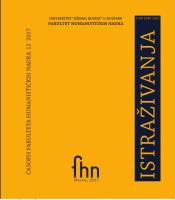Mother-child bonding and spatial androgyny in the film adaptation of Emma Donoghues’s novel Room
Mother-child bonding and spatial androgyny in the film adaptation of Emma Donoghues’s novel Room
Author(s): Tatjana BijelićSubject(s): Language and Literature Studies, Literary Texts
Published by: Fakultet humanističkih nauka, Univerzitet »Džemal Bijedić« u Mostaru
Keywords: mother-child bonding in impossible circumstances; Emma Donoghues’s novel Room; spatial androgyny;
Summary/Abstract: The paper focuses on the notion of spatial androgyny and (im)possible dismantling of patriarchal structures as represented in the film Room (2015), directed by Lenny Abrahamson and based on the awarded same-titled novel (2010) and highly acclaimed screenplay written by Irish-Canadian author Emma Donoghue. Inspired by real-life cases of abduction, rape, and women held captive, the author superimposes a bond between mother and her child within an equally frightening and powerful physically closed space that delineates and defines the characters’ reality. Exploring spatial androgyny in terms of gender fluidity, the analysis of the novel and its film adaptation starts with brief references to both traditional and more revolutionary perspectives on mother-child early symbiotic relationship and its normally subsequent development into the separation-individuation phase. It further embarks on tracking the changes and turning points in the relationship’s dynamics as featured in the film (and, for the purpose of this article, quoted from the novel), connecting the evolution of the primary mother-child bond with its broader social implications and possibilities of release from the imprisonment of patriarchy, its micro-environments and macro-structures.
Journal: Istraživanja
- Issue Year: 2017
- Issue No: 12
- Page Range: 115-129
- Page Count: 15
- Language: English

